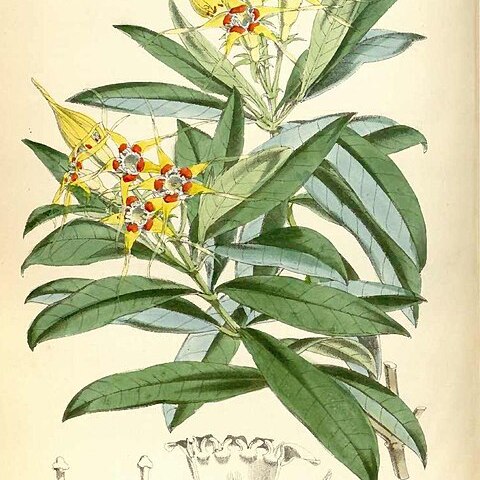Much-branched shrub or woody climber, up to 20 m long; bark warty, with watery sap. Leaves 3-whorled, narrowly elliptic to oblanceolate, 30-80 x 8-20 mm; colleters in axils scale-like, overlapping. Inflorescence terminal, corymbose, up to 16-flowered. Flowers yellowish orange with red mark at base of lobes. Corolla: tube 6-7(-10) mm long; coralline corona lobes at mouth, scale-like, alternating with lobes; lobes linear, spreading, twisted, 25-30 x 2.5 mm. Anthers hidden in corolla tube, long appendage hairy. Gynoecium apocarpous, bicarpellate. Style-stigma-head capitate with thin, reflexed annulus at base, enclosed by anthers. Flowering time Sept., Oct. Fruit a pair of follicles, horizontally diverging, fusiform, 100-180 x 10-15 mm, apex attenuate, abruptly thickened.
Leaves petiolate, ternate, rarely opposite or quaternate; petiole 2–12 mm. long; lamina glossy and medium or dark green above, dull and paler beneath, narrowly elliptic or slightly obovate, 2·5–6(9) times as long as wide, 2·2–11·5 x 0·6–3·4 cm., decurrent into the petiole, acute, acuminate, or rarely rounded at the apex (acumen 1–6 mm. long), often with a slightly revolute margin, coriaceous or thinly so, glabrous, with 6–19 pairs of secondary veins; tertiary venation sometimes conspicuous.
Corolla tube (6·5)9–14 mm., long and widening at 1/3–1/2 of its length into a cyathiform upper part, at the mouth 5·5–11 mm. wide, minutely puberulous near the apex outside, minutely papillose inside; corona lobes subulate, 1·8–4·9 x 1–2·2 mm., minutely papillose; corolla lobes ovate, 2–6 x 3–5 mm., gradually narrowing into the spreading tails; lobes including the tails 19–50 mm. long, puberulous outside and sometimes also near the base inside.
Fruit 1, or occasionally 2, in a single infrutescence; follicles divergent at an angle of (60)100-230°, tapering towards the narrow apex and ending in a minute knob, with the extreme apex sometimes curved inwards, (7)10-22 cm. long and 0·7–1·5 cm. in diam.; exocarp fairly thin, hard, glabrous, not lenticellate.
Scandent shrub or woody climber, up to 10 m high. Leaves narrowly elliptic to oblanceolate, often ternate. Infra-axillary glands scale-like, overlapping vertically like tiles. Plumose awn on seed sessile. Flowers yellow with dull red mark at base of each corolla lobe.
Stamens included for 0–3·5 mm.; filaments straight, 0·5–0·8 mm., long; anthers 3·4–6 x 0·4–1 mm., pubescent in the upper third or for more than half of their length; tails 0·2–0·7 mm. long; acumen 0·9–2·5 mm. long.
Seeds with the grain 13–22 x 2–4·5 mm. densely puberulous; rostrum glabrous for 0–2 mm. and bearing a coma for 7–15 mm.; coma 22–43 mm. long.
Inflorescence 3–26-flowered, pedunculate, congested, glabrous in all parts or puberulous in some; pedicels 6-21 mm. long; bracts sepal-like.
Ovary 0·8–1·8 x 1·2–2·1 mm., puberulous; style 3·9–5·5 mm. long; clavuncula 0·8–1·6 x 0·7–1·9 mm., pubescent at the apex; stigma minute.
Sepals subequal, narrowly ovate, 3–14·5 x 1·2–2(2·7) mm., acute, with some hairs near the apex or puberulous all over.
Shrub, 1–4 m. high, or liana, up to 16 m. high, presumably evergreen; latex clear or white.
Trunk up to 3 cm. in diam., branching trichotomously; branchlets glabrous.


